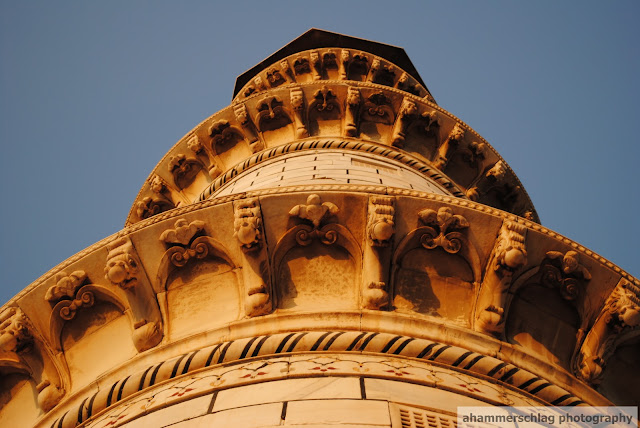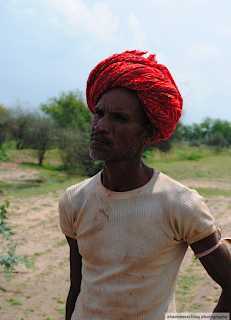 |
| One of Varanasi's holy men |
I spent the last month of my study abroad program doing an independent research project on how the caste system has caused the lower castes to convert to Buddhism and Christianity. Specifically, I was looking at how converting has improved their lives, if at all: have they been able to escape their caste? Which religion has better allowed them to do so? Why?
I ended up with some very interesting answers, and a story which I was not at all expecting. My findings culminated into a thirty page paper which is in the process of being cut down to make it more blogger friendly. If you’re up for reading the whole thing, shoot me an email or post a comment with your email and I will send you the super-sized version. In the meantime, my research took me to some interesting places so I thought I would write a bit about them for now.
Varanasi, Uttar Pradesh
 |
| One of the old buildings of Varanasi |
Previously known as Banares, Varanasi sits alongside the Ganges river and is believed to be the oldest city in the world. Hindus from all over India flock to this city to make use of the dozens of bathing ghats which dot the banks of the river. For Hindus, the Ganges, or Ganga as it is often referred to, is a holy river which, upon contact, will wash away all your sins. For non-Hindus, it is the infectious disease headquarters, which, upon contact, will probably kill you.
Almost a hundred million liters of sewage empty out into the Ganges daily, and for the most part, without bypassing any sort of treatment plant; it is a direct path, from the toilets, to the streets, through the gutters, straight into the river. Scientists say that in order for water to be safe to bathe in, that the fecal coliform count should be no more than 500. Samples from the Ganges have shown that there are more than 5500. I try not to think about this as I sit along the ghats, watching men in their underwear completely submerse themselves in the E.Coli-infested water (women of course wear no such attire, and enter the water fully clothed in their sarees and salwar-kameez).
 |
| The Ganga in the early morning light |
Hindus have been coming here for centuries to wash away their sins, and you would think that by now they would believe that the water is too polluted with billions of sins, at the very least, and would more likely infect a bather with another’s sins rather than rinse more away. But no, they continue to “bathe” in the water, freeing themselves of a sin with each dunk, while simultaneously ingesting some fecal matter. It’s like a business deal: the water will take away your sins in exchange for giving you a disease, a parasite, an amoeba, a virus, maybe even two or three of these, or maybe none at all. Like a Happy Meal, without the toy. Or the meal. And you really don’t want to collect them all.
It is a gamble and I decide that there is no sin which I have committed that would make it worth the risk. I continue to walk along the ghats, enjoying the vibrant atmosphere as kite
 |
| Boat ride along the Ganges |
runners speed past and boat drivers try to attract customers, yelling: “Take a ride on my boat! My boat is the best and fastest on the Ganges!”
I am suddenly hit with a revolting, putrid smell. Smoke rises from a stack of wood on one of the ghats, the source of the repulsive odor. As I get closer, I realize that it is not just a stack of wood that is being burnt; I notice two small brown feet sticking out of the smoke stack. A second body, wrapped in bright orange cloth, lies adjacent to it, awaiting a similar fate.
Varanasi is believed to be a holy place to die and be cremated, and dead bodies are sent here from all parts of the country. It is thought that being cremated here guarantees direct entry into heaven. No stopping at limbo, no collecting two hundred rupees, straight into heaven. This privilege is however reserved for Hindus only, and even within the Hindu population, many groups are excluded.
Children under the age of ten, as well as pregnant women are not allowed to be cremated along the Ganges, nor are leprosy patients, cobra-bite victims, or sadhus (homeless holy men). Children are thought to be innocent, and therefore do not necessitate the removal of sin which the cremation provides. The logic behind the latter group, however, is much more disturbing. These people are thought to be poisonous, and if they are burnt, anyone who inhales the smoke will also be poisoned. Instead of being cremated, these groups are tied to large stones which are then sunk into the Ganges. It is not uncommon for bodies to come untied and float to the surface, a frightening sight for unsuspecting tourists enjoying a leisurely boat ride.
I continued to watch the cremation, and even though I had never even seen a dead body, it was a surprisingly unemotional experience. It made me realized just how much the Western world is hidden from the realities of death; a stark contrast from the children playing around the cremation pyres, completely unfazed by the presence of dead bodies.
A week later I came upon another burning ghat, a larger one which had a special section reserved for Brahmin cremations only. Because the Untouchables are prescribed the unpleasant job of carrying the bodies down to the river, they are required to “purify” themselves in the Ganges before coming into contact with the corpses. This second experience of watching a cremation was far more morbid than the first, as this time not just the feet, but the entire head was sticking out of the fire. But I watched nonetheless as the son of deceased, as is customary, started the fire, and, with tears in his eyes, watched the flames carry his father into heaven.
Bodh Gaya, Bihar
 The Northeast state of Bihar, infamous for having some of India’s highest poverty and illiteracy rates, is also home to where the Buddha is believed to have attained enlightenment. Since Buddhism’s revival in the 18th century, Bodh Gaya has blossomed into a Buddhist pilgrimage hotspot, packed with monasteries, each representing dozens of different Buddhist nations. During the Winter months, maroon and saffron robes color the streets as monks from all over Southeast Asia journey here to enjoy what has become India’s largest Buddhist sanctuary.
The Northeast state of Bihar, infamous for having some of India’s highest poverty and illiteracy rates, is also home to where the Buddha is believed to have attained enlightenment. Since Buddhism’s revival in the 18th century, Bodh Gaya has blossomed into a Buddhist pilgrimage hotspot, packed with monasteries, each representing dozens of different Buddhist nations. During the Winter months, maroon and saffron robes color the streets as monks from all over Southeast Asia journey here to enjoy what has become India’s largest Buddhist sanctuary. Adjacent to the Bodhi tree, under which the Buddha is said to have spent seven weeks meditating before attaining enlightenment, sits the intricately carved Mahabodhi Temple, within which lies a peep-hole into an unsettling past of religious conflict.
 |
| The Mahabodhi Temple |
On the other side of the glass dozens of worshippers fight for a spot in front of this statue to lay their offerings of food, clothing, and flowers on the table standing beneath. A second donation box, the size of a large trash can you would find on a sidewalk, is the room’s centerpiece, and is overflowing with bills. An atmosphere of chaos dominates the room as anxious worshippers desperately try to shove their one hundred rupee bills into the box, while staff attempt to direct them back to the first box which has not yet been filled.
A Buddhist shrine. This phrase becomes a sort of oxymoron when one looks at the original teachings of the Buddha who specifically said that he was not a god to be worshipped and asked that his followers refrain from such illogical rituals.
Due to past Muslim invasions which left hundreds of Buddhist monuments and monasteries in ruins, as well as the overbearing influence of Hinduism, Buddhism has come to have a very weak presence in India.
 |
| Buddhist monks meditating in the ruins of Sarnath which date back to 5 A. D. They used to be monasteries which were torn down by the Muslim invaders. |
It was a sad, unnerving experience to see how this has manifested in such an obvious manner, but I also realized how these circumstances are really not specific to Buddhism at all. It is amazing how far religion can deviate from its original teachings, after all, didn’t Islam, Judaism, and Christianity all stem from the same teachings of Abraham?
Here are some photos the enormous Buddha statue which was commissioned by the Dalai Lama in 1989. Don't mind the power lines in the background.


 |
| Some Buddhist monks meditating in front of the Bodhi tree |
 |
| I was able to make friends with a Thai monk who gave me a VIP tour of Bodh Gaya's most elaborate monastery which tourists generally not allowed to enter |
Here are some more pictures of the ruins at Sarnath
Two of the lower castes whom I interviewed for my project:






































